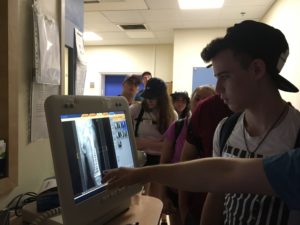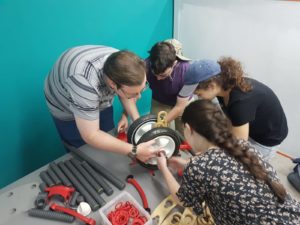By Rabbi David Wilfond, Director of Education
On Sunday, the teens visited the Galilee Medical Center which treats Syrian victims wounded in the bloody civil war, just over the border. This story of humanitarian assistance by Israel is little known outside of Israel. After lunch the group explored one of Israel’s most famous National Parks, The Rosh HaNikra Grottoes.

This features the country’s steepest cable car descent bringing visitors down to the Mediterranean Sea past sheer gleaming white cliffs. At Sea Level the teens learned about the geology of the grottos as they followed a trail that winds in and out of the picturesque grottoes filled with rushing water, crashing waves and the salty spray from the nearby Mediterranean Sea.
Monday provided an opportunity to explore the Israel City of Haifa. The morning was spent at the Oceanography Institute, that gives a hands-on opportunity to learn about life under the sea and to observe the impacts of climate change and pollution on our world’s beaches and sea life. Wading into the ocean the teens found small crabs, shrimp, fish, snail, and a wide diversity of algae and back in the lab they had the opportunity to hold preserved turtles, sharks, squid, octopus and learn about their anatomy. Following an Israeli pizza lunch including corn pizza, a new hit, the teens visited the labs of the Technion, Israel’s oldest University known for its groundbreaking scientific research. At the Technion they visited the Formula car labs where they heard from the student engineers and drivers about the international Formula racecar competitions. From the Technion the group travelled to the Madatech (Hebrew for Sci-Tech), Israel’s interactive science museum that is also the original campus of the Technion, where they had a guided tour of Israel’s latest scientific discoveries and innovations. To chill-out at the end of the day, the teens took in the Bahai Gardens, a botanical extravaganza famous throughout the world.
 Tuesday, the teens met inspiring Israeli entrepreneurs at the Tefen Industrial park workshop. The teens hand a hands-on experience turning raw materials in a technological product, building bicycles, scooters, and other wheeled vehicles. Everyone enjoyed a pre-lunch snack at the Buza ice cream factory, where they heard from the CEO about his journey into the world of ice cream creation and how he uses his ice cream shop, which is owned by himself who is Jewish and his partner who is Muslim, to promote coexistence. Will the delicious lingering taste of ice cream and full stomachs, the group ascended to the ancient mountain top town of Tzfat. This town was home to Jewish Kabbalah-mystics who revolutionized Jewish Spirituality in the 1500’s, creating the Kabbalists’ Shabbat Service (known as “Kabbalat Shabbat”.) This religious innovation from Tzfat, is observed in every virtually Reform Synagogue today!) Here, the Kabbalists also composed the most famous of all Shabbat Songs, “Lecha Dodi.” The phrase “Tikkun Olam” was also first created here by the Kabbalists of Tzfat as a belief that one’s deeds on earth have ethical implications for the entirety of the cosmos.
Tuesday, the teens met inspiring Israeli entrepreneurs at the Tefen Industrial park workshop. The teens hand a hands-on experience turning raw materials in a technological product, building bicycles, scooters, and other wheeled vehicles. Everyone enjoyed a pre-lunch snack at the Buza ice cream factory, where they heard from the CEO about his journey into the world of ice cream creation and how he uses his ice cream shop, which is owned by himself who is Jewish and his partner who is Muslim, to promote coexistence. Will the delicious lingering taste of ice cream and full stomachs, the group ascended to the ancient mountain top town of Tzfat. This town was home to Jewish Kabbalah-mystics who revolutionized Jewish Spirituality in the 1500’s, creating the Kabbalists’ Shabbat Service (known as “Kabbalat Shabbat”.) This religious innovation from Tzfat, is observed in every virtually Reform Synagogue today!) Here, the Kabbalists also composed the most famous of all Shabbat Songs, “Lecha Dodi.” The phrase “Tikkun Olam” was also first created here by the Kabbalists of Tzfat as a belief that one’s deeds on earth have ethical implications for the entirety of the cosmos.
July 4th (or rather Erev July 4th) was celebrated American and Israeli Style with a BBQ and pool party filled with American and Israeli tunes.
As we celebrated July 4th in the United States this week, it seems appropriate to share a bit about the meaning of July 4th for Israelis. It was on this day in 1976 that Israel sent a commando mission to Entebbe, Uganda to rescue over 100 Jews being held hostage by terrorist hijackers. July 4th is powerful date for Jews. On July 4, 1946 a year after the end of WWII, 42 Jewish survivors of the Holocaust were brutally murdered in Kielce, Poland by their Polish neighbors because they, the Jews, had dared to come back to live again in their homes in Poland. In 1946 Jewish life was cheap and one could murder Jews freely without protest, as tragically occurred to the Jews in Kielce. Exactly 30 years later to the day, 102 Jewish hostages of a combined German and Palestinian Terrorist Cell were in danger of being murdered in Entebbe. One of the big differences between 1946 and 1976 was the existence of the State of Israel and the IDF. Israel does not exist just to protect Israelis. Israel sees as its mission to protect Jews anywhere they are in danger. This is why Israel has done so much over the years to rescue Ethiopian Jews and Russian Jews. In 1976 over a hundred Jews were in mortal danger in Uganda, so what did Israel do? They sent their soldiers in the dark of night on daring rescue mission 2,500 miles away and brought the hostages back to safety in Israel. In 1976 Jews around the world felt safer than Jews just thirty years before in Poland. The difference is that in 1976 the State of Israel had already come into existence. Israel looks out for the safety of Jews where ever they live. This is a powerful message of Jewish responsibility that has become a big part of July 4th memories in Israel.
